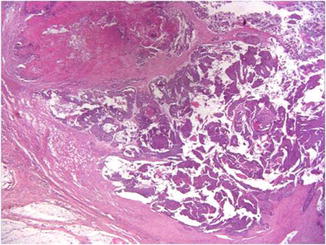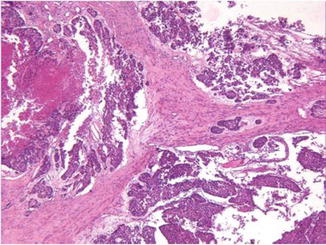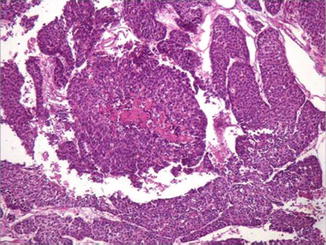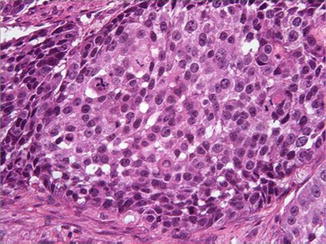Fig. 13.1
Nodular ulcerated lesion on the left upper chest
Pathology
The tumor is asymmetrical and poorly circumscribed and has a large size, usually extending throughout the dermis and subcutaneous fat (Fig. 13.2). The tumor usually has an infiltrating border. It can be locally aggressive with involvement of the fascia, skeletal muscle, and even bone. Some tumors demonstrate vascular, lymphatic, or perineural invasion. The lesion is composed of aggregates of neoplastic cells that vary greatly in shape and size and have jagged borders and a tendency for confluence. Extensive necrosis en masse is often present within these aggregations. Areas of dystrophic calcification can sometimes be present. The aggregates are composed of two populations of cells, namely, the basaloid cells and the “shadow” or “ghost” cells (Fig. 13.3). The basaloid cells usually predominate over the shadow cells (Fig. 13.4). The basaloid cells are neoplastic, matrical cells that have pleomorphic and hyperchromatic nuclei and prominent nucleoli, scant cytoplasm, and numerous mitotic figures, including many atypical ones (Fig. 13.5). They give rise to the second population of shadow cells gradually or in a more abrupt fashion. The shadow cells have pale, eosinophilic cytoplasm and discrete ghost nuclei (Fig. 13.6). Sometimes, dendritic melanocytes can be seen between the basaloid cells and are responsible for the brown pigmentation of the tumor. The tumor is usually accompanied by a dense lymphoplasmacytic infiltrate. Granulomatous inflammation of foreign body type around foci of shadow cells can also be identified.




Fig. 13.2
This large epithelial neoplasm occupies the whole dermis and extends into the subcutaneous fat. It is composed of aggregations of neoplastic cells that vary in shape and size and have jagged borders

Fig. 13.3
The aggregations are composed of two populations of cells, namely, the basaloid cells and the “shadow” or “ghost” cells. Extensive necrosis en masse is present within some aggregations

Fig. 13.4
The basaloid cells predominate over the shadow cells










